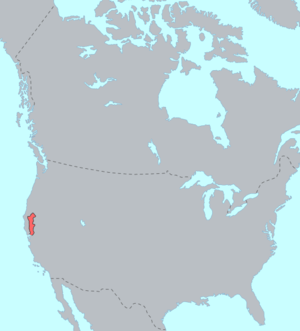Wintuan languages
Wintuan (also Wintun, Wintoon, Copeh, Copehan) is a family of languages spoken in the Sacramento Valley of central Northern California.
| Wintun | |
|---|---|
| Copeh | |
| Ethnicity | Wintun people |
| Geographic distribution | California |
| Linguistic classification | Penutian ?
|
| Subdivisions |
|
| Glottolog | wint1258[1] |
 Pre-contact distribution of Wintuan languages | |
All Wintuan languages are either extinct or severely endangered.
Classification
Family division
Shipley (1978:89) listed three Wintuan languages in his encyclopedic overview of California Indian languages. More recently, Mithun (1999) split Southern Wintuan into a Patwin language and a Southern Patwin language, resulting in the following classification.
I. Northern Wintuan
II. Southern Wintuan
- 3. Patwin (a.k.a. Patween)
- 4. Southern Patwin (†)
Wintu became extinct with the death of the last fluent speaker in 2003 (Golla 2011:143). Nomlaki has at least one partial speaker (as of 2010, Golla 2011:143). One speaker of Patwin (Hill Patwin dialect) remained in 2003 (Golla 2011:145). Southern Patwin, once spoken by the Suisun local tribe just northeast of San Francisco Bay, became extinct in the early 20th century and is thus poorly known (Golla 2011:146; Mithun 1999). Wintu proper is the best documented of the four Wintuan languages.
Pitkin (1984) estimated that the Wintuan languages were about as close to each other as the Romance languages. They may have diverged from a common tongue only 2,000 years ago. A comparative study including a reconstruction of Proto-Wintun phonology, morphology and lexicon was undertaken by Shepherd (2006).
Possible relations to external language families
The Wintuan family is usually considered to be a member of the hypothetical Penutian language phylum (Golla 2011:128-168) and was one of the five branches of the original California kernel of Penutian proposed by Roland B. Dixon and Alfred L. Kroeber (1913a, 1913b). However, recent studies indicate that the Wintuans independently entered California about 1,500 years ago from an earlier location somewhere in Oregon (Golla 2007:75-78). The Wintuan pronominal system closely resembles that of Klamath, while there are numerous lexical resemblances between Northern Wintuan and Alsea that appear to be loans (Golla 1997; DeLancey and Golla 1997; Liedtke 2007).
References
- Hammarström, Harald; Forkel, Robert; Haspelmath, Martin, eds. (2017). "Wintuan". Glottolog 3.0. Jena, Germany: Max Planck Institute for the Science of Human History.
Bibliography
- DeLancey, Scott & Victor Golla (1997). The Penutian hypothesis: Retrospect and prospect. International Journal of American Linguistics, 63, 171-202.
- Dixon, Roland B. & Alfred L. Kroeber (1903). The native languages of California. American Anthropologist, 5, 1-26.
- Dixon, Roland B. & Alfred L. Kroeber (1913a). New linguistic families in California. American Anthropologist, 15, 647-655.
- Dixon, Roland B. & Alfred L. Kroeber (1913b). Relationship of the Indian languages of California. Science, 37, 225.
- Dixon, Roland B. & Alfred L. Kroeber (1919). Linguistic families of California. University of California Publications in American Archaeology and Ethnology 16:47-118. Berkeley: University of California.
- Golla, Victor (1997). The Alsea-Wintu connection. International Journal of American Linguistics, 63, 157-170.
- Golla, Victor (2007). Linguistic Prehistory. California Prehistory: Colonization, Culture, and Complexity, pp. 71–82. Terry L. Jones and Kathryn A. Klar, editors. New York: Altamira Press. ISBN 978-0-7591-0872-1.
- Golla, Victor (2011). California Indian languages. Berkeley: University of California Press. ISBN 978-0-520-26667-4.
- Grant, Anthony (1997). Coast Oregon Penutian. International Journal of American Linguistics, 63, 144-156.
- Liedtke, Stefan (2007).The Relationship of Wintuan to Plateau Penutian. LINCOM studies in Native American linguistics, 55. Muenchen: Lincom Europa. ISBN 978-3-89586-357-8
- Mithun, Marianne (1999). The languages of Native North America. Cambridge: Cambridge University Press. ISBN 0-521-23228-7 (hbk); ISBN 0-521-29875-X.
- Pitkin, Harvey (1984). Wintu grammar. University of California publications in linguistics (Vol. 94). Berkeley: University of California Press. ISBN 0-520-09612-6.
- Pitkin, Harvey (1985). Wintu dictionary. University of California publications in linguistics (Vol. 95). Berkeley: University of California Press. ISBN 0-520-09613-4.
- Schlichter, Alice (1981). Wintu Dictionary. Report #2 of the Survey of California and Other Indian Languages. Department of Linguistics, University of California at Berkeley.
- Shepherd, Alice (1989). Wintu texts. Berkeley: University of California Press. ISBN 0-520-09748-3.
- Shipley, William F. (1978). Native Languages of California. Handbook of North American Indians, Vol. 8 (California), pages 80–90. William C. Sturtevant, and Robert F. Heizer, eds. Washington, DC: Smithsonian Institution. ISBN 0-16-004578-9 / 0160045754.
- Shepherd, Alice (2006). Proto-Wintun. University of California publications in linguistics (Vol. 137). Berkeley: University of California Press.
- Whistler, Kenneth W. (1977). Wintun Prehistory: An Interpretation based on Linguistic Reconstruction of Plant and Animal Nomenclature. Proceedings of the Third Annual Meeting of the Berkeley Linguistics Society, February 19–21. pp. 157–174. Berkeley.
- Whistler, Kenneth W. (1980). Proto-Wintun kin classification: A case study in reconstruction of a complex semantic system. (Doctoral dissertation, University of California, Berkeley).
External links
| Wikimedia Commons has media related to Wintuan languages. |
| Wiktionary has a list of reconstructed forms at Appendix:Proto-Wintun reconstructions |